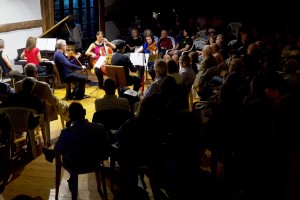
” …deeply committed performers, working in close proximity to the audience, gives the audience access to levels of emotional and intellectual exhilaration that they may not have known were possible in live performance.”
Photo by: Tom Bushey
WCM’s 2014 summer season is now history, and truly one for the record books. I loved all of it, luxuriated in it even, and when I think about it now I’m amazed, stupefied really, at how much we were able to pull off in a scant two-week period. So many things came together, with such beauty and grace, thanks to the incredible work of so many people, that when it was over one could only feel both very lucky and utterly exhausted.
Among the highlights: having composer Shulamit Ran on hand for the full two-week run, giving both the players and the audience multiple chances to get to know her and her exquisite music; our evening with Shulamit and festival artists at the Catskill Distilling Company; the Brahms G Major sextet; the Ravel Duo for violin and cello; dance at the North Branch Inn with Donlin Foreman and Jenny Emerson; lunches on the Eddie Adams porch; playing for the first time at the Cooperage in Honesdale PA; hearing Pavel Vinnitsky play my first Klezmer arrangement; the joy of hearing two of my works played by gifted and devoted friends; the revelation of under-appreciated Mendelssohn; hearing Judith and the gang connect with Shulamit’s formidable Mirage; and the list goes on and on…
One thing that occurred to me both during and after the festival, is that there’s nothing meta about it. In this way, I suppose, we’re not hip, but then again we’re not trying to be (though we do hope to be fresh and imaginative and not stodgy). There’s no ironic distance here, no hedging of emotional bets, no shying away from our commitment to what we see as an endlessly evolving great tradition. We play Brahms and Mendelssohn and Ravel and Ran as if our lives depended on it, and we have fun in the process. We are ecstatically dead serious about what we do, and the connection we feel with the audience tells us that they feel the same way about it. No one is there to be seen, no one is working the room. We’re just in the music and the circle of love and friendship that the music creates. It’s a magic circle and talking about it in this way is dangerously engaged and un-self-conscious, and we don’t care.
Here’s what we believe, perhaps in our naiveté, is happening: a vital mix of old and new music, with caring, brilliantly gifted and deeply committed performers, working in close proximity to the audience, gives the audience access to levels of emotional and intellectual exhilaration that they may not have known were possible in live performance. This is what we, as human beings, want from an aesthetic encounter: magic, power, a heightened sense of the real, of the possible. Anything less, anything that is mere publicity, fad, attitude, look or idea, is a cheat.
As our audience grows, we have to conclude that we’re on target here. We don’t know exactly why they’re coming (anyone who thinks they fully understand an audience’s comings and goings do is sadly mistaken), but we do know that when they find us they generally stay with us. We know how precious this is, and we won’t abuse their trust. We’ll keep at it, and as we do we’ll keep varying the conversation, taking it in directions that it hasn’t traveled before, always with an ear toward re-invigorating the relationship.
We do this because we must; because we’re worn out from a contemporary world of gadgets, distractions and false connections. We want to know that we can connect for real around things that matter, that move us, that last, and that will keep moving us in endlessly varied ways for as long as we choose to return to them. We know that, miraculously, Shulamit’s Lyre of Orpheus, or Brahms’s magisterial Sextet will be different pieces for us the next time we hear them, even as we recognize everything in them that makes them specific and unmistakable. This weirdly tangible realm of musical relationship, a fractal world of pattern and variation, of kaleidoscopic motion from thought into feeling and back again, is vividly opened to us through performances like the ones we heard this summer.
For those who hear the music for the first time in this way there is a memory that remains eternally present and alive; for those whose first point of reference is a recording there is an amplification of understanding, an opening-out of potential within something they thought they already knew. In both cases, the live performance is essential. And that’s where we come in.
We’re not alone in this, of course. All over the country we’re seeing a renaissance, in the form of festivals, offbeat series, and house concerts, of serious, go-for-broke music making. And audiences are responding, seeking out performances that are intense and truthful. Some examples are legendary, such as Peggy Pearson’s Winsor Music series in Boston; Token Creek in Wisconsin; Piano Spheres in Los Angeles. Others live in (what one assumes to be) happy obscurity, worrying less about branding than about the right acoustic for their next concert of music by Grisey, or the Art of Fugue of Bach, or the songs of Jobim. What they all have in common, all these small and, in some cases, unlikely operations, is a firm conviction around what they owe their audiences: truth; challenge; excitement; beauty; love. That’s certainly the WCM litany, and will be for as long as we’re around.
Why settle for anything less?
